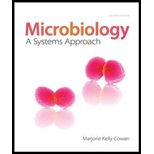
Microbiology: A Systems Approach
4th Edition
ISBN: 9780073402437
Author: Marjorie Kelly Cowan Professor
Publisher: McGraw-Hill Education
expand_more
expand_more
format_list_bulleted
Concept explainers
Question
Chapter 6.7, Problem 18AYP
Summary Introduction
To enlist:
The three non-cellular infectious agents besides viruses.
Concept introduction:
Infectious agents are something that can cause an infection by invading into a specific host organism. There are four main classes of infectious agents: viruses, bacteria,
Expert Solution & Answer
Want to see the full answer?
Check out a sample textbook solution
Students have asked these similar questions
glg 112 mid unit assignment Identifying melting processes
Give only the mode of inheritance consistent with all three pedigrees and only two reasons that support this, nothing more, (it shouldn't take too long)
O
Chapter 6 Solutions
Microbiology: A Systems Approach
Ch. 6.1 - Describe the significance of viruses being...Ch. 6.2 - Summarize arguments on both sides of the debate...Ch. 6.2 - Identify effective terms to describe the behavior...Ch. 6.3 - Prob. 4AYPCh. 6.3 - Describe the function and structure(s) of viral...Ch. 6.3 - Distinguish between enveloped and naked viruses.Ch. 6.3 - Prob. 7AYPCh. 6.3 - Compare and contrast the composition of a viral...Ch. 6.3 - Diagram the possible nucleic acid configurations...Ch. 6.4 - Develop two arguments against assigning species...
Ch. 6.4 - Demonstrate how family and genus names in viruses...Ch. 6.5 - Prob. 2CFCh. 6.5 - Diagram the six-step life cycle of animal viruses.Ch. 6.5 - Define the term cytopathic effect and provide one...Ch. 6.5 - Provide examples of persistent and transforming...Ch. 6.5 - Provide a thorough description of lysogenic and...Ch. 6.6 - List the three principal purposes for cultivating...Ch. 6.6 - Describe three ways in which viruses are...Ch. 6.7 - Prob. 18AYPCh. 6.8 - Analyze the relative importance of viruses in...Ch. 6.8 - Prob. 20AYPCh. 6 - Prob. 1CFCh. 6 - A virus is a tiny infectious a. cell. b. living...Ch. 6 - Viruses are known to infect a. plants. b....Ch. 6 - The nucleic acid of a virus is a. DNA only. b. RNA...Ch. 6 - The general steps in a viral multiplication cycle...Ch. 6 - Prob. 5MCQCh. 6 - In general, RNA viruses multiply in the cell ____,...Ch. 6 - Viruses cannot be cultivated in/on a. tissue...Ch. 6 - Clear patches in cell cultures that indicate sites...Ch. 6 - Label the parts of this virus. Identify the...Ch. 6 - Circle the viral infections from this list:...Ch. 6 - In lysogeny, viral DNA is inserted into the host...Ch. 6 - A viral capsid is composed of subunits called...Ch. 6 - The envelope of an animal virus is derived from...Ch. 6 - The nucleic acid of animal viruses enters the cell...Ch. 6 - Viruses that persist in the (host) cell and cause...Ch. 6 - Provide evidence in support of or refuting the...Ch. 6 - Summarize the unique properties of viruses and...Ch. 6 - Prob. 3CTQCh. 6 - Prob. 4CTQCh. 6 - Prob. 5CTQCh. 6 - Prob. 6CTQCh. 6 - Prob. 7CTQCh. 6 - Prob. 8CTQCh. 6 - Prob. 9CTQCh. 6 - Prob. 10CTQCh. 6 - Prob. 1CCCh. 6 - Prob. 2CCCh. 6 - Prob. 3CCCh. 6 - Prob. 4CCCh. 6 - Prob. 1VCCh. 6 - Prob. 1CM
Knowledge Booster
Learn more about
Need a deep-dive on the concept behind this application? Look no further. Learn more about this topic, biology and related others by exploring similar questions and additional content below.Similar questions
- Describe the principle of homeostasis.arrow_forwardExplain how the hormones of the glands listed below travel around the body to target organs and tissues : Pituitary gland Hypothalamus Thyroid Parathyroid Adrenal Pineal Pancreas(islets of langerhans) Gonads (testes and ovaries) Placentaarrow_forwardWhat are the functions of the hormones produced in the glands listed below: Pituitary gland Hypothalamus Thyroid Parathyroid Adrenal Pineal Pancreas(islets of langerhans) Gonads (testes and ovaries) Placentaarrow_forward
- Describe the hormones produced in the glands listed below: Pituitary gland Hypothalamus Thyroid Parathyroid Adrenal Pineal Pancreas(islets of langerhans) Gonads (testes and ovaries) Placentaarrow_forwardPlease help me calculate drug dosage from the following information: Patient weight: 35 pounds, so 15.9 kilograms (got this by dividing 35 pounds by 2.2 kilograms) Drug dose: 0.05mg/kg Drug concentration: 2mg/mLarrow_forwardA 25-year-old woman presents to the emergency department with a 2-day history of fever, chills, severe headache, and confusion. She recently returned from a trip to sub-Saharan Africa, where she did not take malaria prophylaxis. On examination, she is febrile (39.8°C/103.6°F) and hypotensive. Laboratory studies reveal hemoglobin of 8.0 g/dL, platelet count of 50,000/μL, and evidence of hemoglobinuria. A peripheral blood smear shows ring forms and banana-shaped gametocytes. Which of the following Plasmodium species is most likely responsible for her severe symptoms? A. Plasmodium vivax B. Plasmodium ovale C. Plasmodium malariae D. Plasmodium falciparumarrow_forward
- please fill in missing parts , thank youarrow_forwardplease draw in the answers, thank youarrow_forwarda. On this first grid, assume that the DNA and RNA templates are read left to right. DNA DNA mRNA codon tRNA anticodon polypeptide _strand strand C с A T G A U G C A TRP b. Now do this AGAIN assuming that the DNA and RNA templates are read right to left. DNA DNA strand strand C mRNA codon tRNA anticodon polypeptide 0 A T G A U G с A TRParrow_forward
arrow_back_ios
SEE MORE QUESTIONS
arrow_forward_ios
Recommended textbooks for you
 Comprehensive Medical Assisting: Administrative a...NursingISBN:9781305964792Author:Wilburta Q. Lindh, Carol D. Tamparo, Barbara M. Dahl, Julie Morris, Cindy CorreaPublisher:Cengage LearningBasic Clinical Lab Competencies for Respiratory C...NursingISBN:9781285244662Author:WhitePublisher:Cengage
Comprehensive Medical Assisting: Administrative a...NursingISBN:9781305964792Author:Wilburta Q. Lindh, Carol D. Tamparo, Barbara M. Dahl, Julie Morris, Cindy CorreaPublisher:Cengage LearningBasic Clinical Lab Competencies for Respiratory C...NursingISBN:9781285244662Author:WhitePublisher:Cengage




Comprehensive Medical Assisting: Administrative a...
Nursing
ISBN:9781305964792
Author:Wilburta Q. Lindh, Carol D. Tamparo, Barbara M. Dahl, Julie Morris, Cindy Correa
Publisher:Cengage Learning

Basic Clinical Lab Competencies for Respiratory C...
Nursing
ISBN:9781285244662
Author:White
Publisher:Cengage
